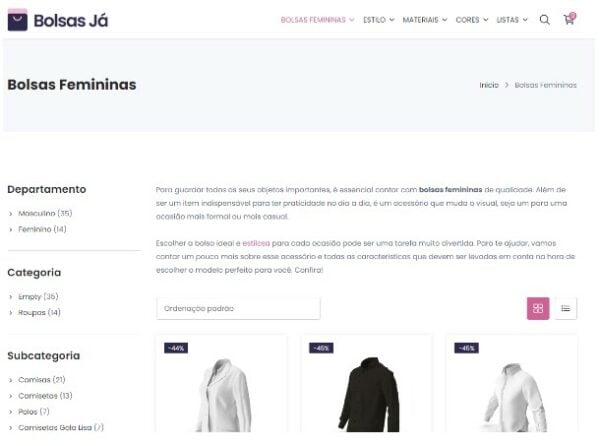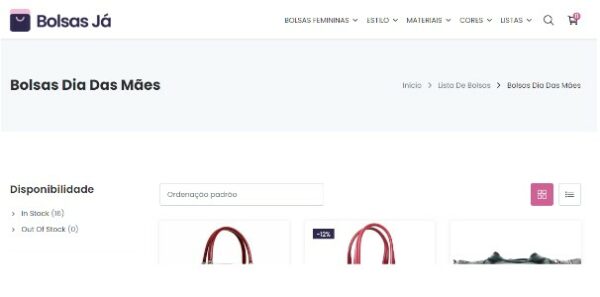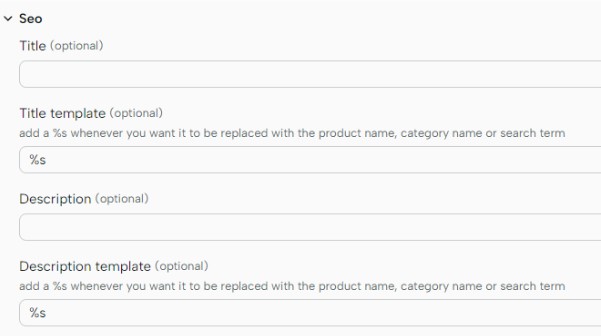Summary
Introduction
What points should be considered?
1 - Mobile Support
2 - URL Support
3 - Content Structure
4 - HTML Content Application Support
5 – Blog Creation in Directory
6 – Collection Creation
7 – Custom Landing Pages Creation
8 – WEBp Support
9 – Free Editing for Meta Description, Title Tag and Headers
10 – Organization of Third-party Tags and Codes
11 – Custom Filter Handling (to avoid becoming an indexable URL)
12 – Framework Support for Search Engines
13 – Headless Architecture
14 – Product Organization and Availability
15 – Site Availability
After all, what is the best e-commerce platform in terms of SEO?
Development and implementation costs
Conclusion
Introduction
With the popularization and diffusion of SEO strategies and projects, it is essential to consider an efficient platform with support for all search engine recommendations. But the main question is: what is the best e-commerce platform in terms of SEO?
We at Gear SEO believe that this question can only be answered through the accumulated experience of SEO work with all of them. Among the platforms we have worked with, we can affirm that all of them have their pros and cons.
There are platforms that meet the basic technical recommendations of SEO and platforms that meet almost all the technical recommendations we have worked with.
Given this scenario, we have compiled a list of the main technical recommendations that we consider an e-commerce platform should contain in terms of SEO support. This survey is based on our experience working with the main e-commerce platforms over the years.
This will be important because it can guide the choice of the platform according to the points it covers or the points that should be considered in the development of a proprietary platform. In this universe we consider both commercial e-commerce platforms and open-source e-commerce platforms.
We also have our demonstrative e-commerce where we apply all the fundamentals of SEO through our "SEO in Practice" program. Bolsas Já is a headless e-commerce using the Deco platform with a Shopify backend.
What Points Should Be Considered?
Below is a list with the points that we consider important for an e-commerce to yield more effective SEO results, taking into account a project where all pages are worked on.
1 - Mobile Support
This point is one of the most important, if not the most. It is essential that the platform considers a responsive site with satisfactory loading time.
When we talk about a responsive site, it means that it should be the same site for desktop and mobile, including the same URL. Google is already committed to completely changing the way sites are crawled, prioritizing the mobile versions of all of them.
In this dynamic, specific sites for mobile (m.site.com.br) will cease to exist, making room for responsive sites. In fact, Google already has documentation and recommendations for this change.
Bolsas Já is an example of a 100% responsive mobile application, meeting all technical SEO requirements.

2 - URL Support
As unimportant as it may seem, a platform that offers support to customize URLs as much as possible is always better when it comes to SEO.
A clear example is a platform where category pages must necessarily contain, at the second level, the classification /collection/, and products must necessarily contain, at the second level, the classification /products/.
No matter how small the detail, we will be at a disadvantage in the competition when the platform offers more flexible URL customization, considering that the use of the keyword in the URL is a good optimization practice recommended by Google.
In the Bolsa Já site, we customized 100% of the Category and Subcategory URLs so that they all remained at the first level of URL navigation. With this, we increased the relevance of the pages in relation to the home page.
Category: https://bolsasja.com.br/bolsas-femininas
Subcategory: https://bolsasja.com.br/bolsa-casual
3 - Content Structure
Successful SEO projects increasingly bring e-commerce closer to content. See some examples below:

Notice that on the category page of the site, there is significant space for content insertion.
Today having an e-commerce on one side and a blog created and used on a subdomain blog.site.com.br is no longer a guarantee of successful SEO work. Therefore, if the e-commerce platform offers this type of support for content creation, it will be a differentiator in terms of SEO.
The Bolsas Já site is an example where we can apply content, images, and HTML elements in categories and subcategories, while working with the products at the same time.

4 - HTML Content Application Support
Following the above example, if the platform offers support for creating a content structure in e-commerce in HTML, it will be possible to insert images, internal links, and other HTML attributes that will be favorable for an SEO project.
5 – Blog Creation in Directory
There are platforms that allow the creation of content components or a blog directly at the second level of the URL.
Example: yoursite.com.br/blog
This option allows you to work with content directly on the URL, avoiding the creation of a subdomain outside of the site. As mentioned above, the closer the content is to the domain, the better the chances of results.
The example of Bolsa Já uses the Fashion Tips subdirectory to display content related to the segment within without the need to create a subdomain.

6 – Collection Creation
Look at this URL: https://www.dafiti.com.br/rasteiras-com-pedras/.
Basically, a collection of products was created in a personalized URL that is not directly linked to the catalog and the product menu. This is only possible because the platform allows new product collections to be created without needing to be associated with the navigation menu or the category tree.
With this, it will be possible to create content and collections that are not directly associated with the menu (for example, "Carnival clothes", "dog outfits", etc.) and enhance work with long-tail keywords highly prone to conversion.
In addition, it will also be possible to create a menu or an exclusive section for this type of page. The example in the image below (cea.com.br) is the creation of a glossary only with terms that are not contained in the menu but are considered relevant in terms of organic search traffic.
7 – Custom Landing Pages Creation
The URL https://www.kabum.com.br/hotsite/blackfriday/ is an example where it is possible to create a 100% customized Landing Page without direct association for viewing products.
Generally, this strategy is used for creating seasonal pages for specific content. Precisely on the date of the occasion (Christmas, Black Friday, Mother's Day, etc.), this page is redirected to a product showcase URL, leveraging the organic traffic developed throughout the year.
In the Bolsas Já website, it is possible to create both collections and customized Landing Pages:
https://bolsasja.com.br/bolsa-caramelo/: These are collections created based on keywords and search volume, and, as explained above, there is no direct relationship with the navigation tree.
https://bolsasja.com.br/bolsas-dia-das-maes: A Landing Page created exclusively to meet a seasonal demand with keywords and search volume for an SEO project.

8 – WEBp Support
According to Google (https://developers.google.com/speed/webp/faq), images in Webp format have a size reduction of up to 30% compared to traditional image formats (PNG, JPG, GIF). The Webp format itself already makes the site faster and, consequently, more advantageous in terms of SEO. A platform that supports this format is highly recommended.
9 – Free Editing for Meta Description, Title Tags, and Headers
Even today, there are platforms where the titles and meta descriptions of pages are created automatically, not allowing customization. This mainly occurs with product pages, specifically with the h1 headers.
As a result, we lose control of all the titles and meta descriptions that exceed the character limit for display in search engines. Consider manually customizing the 20% most important products in your e-commerce if you have many products.

10 – Organization of Third-party Tags and Codes
There are platforms where all insertions of third-party tags and codes (Google Analytics, conversion pixels, etc.) are supported only at the beginning of the page, in many cases hindering the site's loading time. Consequently, this can be a disadvantage in an SEO project.
Ideally, platforms should offer support for inserting third-party tags and codes at the bottom of the site, facilitating the loading of what really matters: the content of the site.
11 – Handling of Custom Filters (to prevent them from being transformed into an indexable URL)
There are several platforms that do not offer support for avoiding pagination results or filters used on the site to be indexed by search engines, harming the most relevant pages. For example:
seusite.com.br/categorias/categoria-1
seusite.com.br/categorias/categoria-1/?ordenacao=true&pagina=3
Both URLs are indexing and being displayed in search engines. However, the only one that should be displayed is seusite.com.br/categorias/categoria-1. The platform should have a solution so that these filter and pagination URLs are not shown in the search results.
12 – Framework Support for Search Engines
There are platforms that use Javascript frameworks (for more information visit: https://www.excellentwebworld.com/what-is-a-single-page-application/) to improve the user experience, making navigation more efficient and facilitating the development process. Widely used frameworks such as Angular, Vue, and React already have support for search engines to properly crawl and index all pages.
However, there are still platforms that use frameworks that compromise the site's performance in search engines. It is extremely important to make sure that the platform has the appropriate support. Generally, this practice occurs on proprietary sites, where the company is 100% responsible for the development.
13 - Headless Architecture
Another important point is the use of e-commerce in a headless format, where the back-end and front-end are completely separate and integrated via API. This brings more autonomy to the development of the front-end and also creates independence from a single platform for SEO work.
Deco is an example of a 100% headless platform where it is possible to integrate the front-end with the main platforms (VTEX, Linx, Shopify, VNDA, Wake), conceived enable development of an e-commerce where all SEO premises are met.
Currently, we have the Bolsas Já site being developed with the back-end in Shopify and the front-end on Deco. This gives us more autonomy to implement features and execute all the technical tasks on the front-end without impacting the operation of the e-commerce.
14 – Organization and Availability of Products
In most e-commerces, when a product is out of stock or permanently withdrawn from sale, both the product and its URL are removed, leading all organic visits to 404 error pages. In some platforms, the only possible option is to redirect this URL to another similar URL or to the homepage.
This practice works in the short term, until Google naturally removes the result from the organic search, since the page no longer matches the keyword. But what if we had the option to keep the URL available even with the product missing, and direct the visitor's navigation to similar products in the site?
This practice would allow the product to continue in organic searches and also continue bringing organic traffic into the site, guiding the visitor to a product close to what they were looking for.
15 – Site Availability
Shockingly, there are still large e-commerces that have to go offline for minutes or even hours during the night to run internal processes.
There is even a concern in the market regarding one of the largest Brazilian e-commerce platforms during Black Friday: the platform has been offline during the Black Friday period, leaving the sites inaccessible and compromising the performance of client sales.
If you hear from any platform that this is normal, run away! Analyze the contract well and be sure that your site is 100% available and functional. Of course, unavailability can occur, but it should be treated as an exception, not a rule. ERP update routines, integration with marketplaces, product updates, and inventory cannot stop the e-commerce under any circumstances.
Why is this bad for SEO?
Imagine a site that, for some reason mentioned above, is offline daily between 2 a.m. and 3 a.m. In terms of visits and revenue, it may not have such a big impact, but there is no prediction of when the indexing robots will scan the site. Surely, at some point, the site will be scanned and not be online. The consequence? Moving down on rankings and loss of organic traffic.
All e-commerce platforms have their pros and cons, and most of them will not meet all of the above requirements. So, when deciding on the platform, consider that the more support it gives, the easier it will be to execute a successful SEO project, avoiding future headaches.
After all, what is the best e-commerce platform in terms of SEO?
We conducted a study with the main e-commerce platforms and considered all the technical tasks we have performed on them.
We grouped all the technical tasks we have worked on and defined the following criteria: the feasibility of applying complex SEO techniques and the complexity of these technical applications. For the first, we simply considered the possibility of implementing a particular task or not. For complexity, we considered the time and effort required to perform these technical tasks.
As shown on the graph above, the few technical tasks that we managed to implement using Loja Integrada, for example, were simple and easy to apply, (robots.txt configuration, titles, meta descriptions, etc.). With Deco, it is possible to apply the largest number of technical recommendations with low implementation complexity.
Remember that the platform alone will not be responsible for 100% of the success of an SEO project, but it should at least offer the support for this project to evolve satisfactorily.
Development and Implementation Costs
Because Deco is 100% independent and integrable with the main platforms on the market, it brings development flexibility to agencies like ours that execute SEO projects. Instead of having to become specialists in developing on specific platforms, where we have to follow guidelines that are not always favorable to our work, we can execute entire projects using Deco only, regardless of the other platforms and systems used by the client.
This flexibility has brought a different dynamic in the application of technical tasks and also changes to our business model. At Gear SEO, for example, the entire development process with Deco is based on activities and implementations and not just on hours worked. This point is positive because the price is not defined by the number of hours invested in a task, but in the resolution of each task.
Likewise, there will no longer be a need for an agency specialized in a particular platform to meet the technical and SEO needs of an e-commerce. At Gear SEO, we have a complete solution for the development of the entire front-end.
Conclusion
As mentioned at the beginning of this article there is no platform that is 100% adherent to SEO technical applications. However, there are platforms that are closer to this reality. Deco, for example, is the platform closest to supporting the application of all the technical tasks we have already performed on an e-commerce platform.
The Deco platform was designed and built to meet specific SEO needs. In this scenario, Gear SEO has a specialized team in creating, developing, and maintaining e-commerces using the Deco platform.
The advantages of working with Gear SEO in the development of an e-commerce using the Deco platform are numerous:
- Ability to customize the front-end through Deco's CMS module;
- Gear SEO is 100% responsible for the development and maintenance of the e-commerce front-end, eliminating the need to hire multiple agencies.
- Gear SEO will be able to perform all technical applications directly in the e-commerce, ensuring the quality and organization of all implementations;
- Ease of integration and organization with third-party applications;
- Agility in updating layout, design, and, most importantly, in monitoring technical recommendations due to the changes of search algorithms;
- It is important to consider the role of SEO in a project from its conception, taking into account the work needed on each front (Strategy, On-Page, Content Production, and Link Building).
This is why an e-commerce platform should be chosen as a basis to meet SEO needs, instead of being just another acquisition channel, working partially or limitedly. A project where SEO technical recommendations work partially or limitedly is most of the time unsuccessful, especially when it comes to increasing conversion rates.
Do you know of any other important points that should be considered? Comment below and participate.